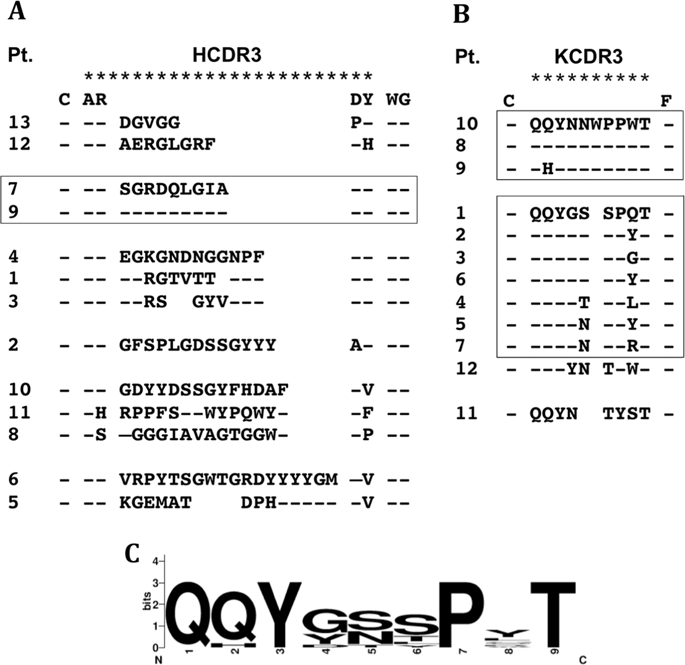当前位置:
X-MOL 学术
›
Genes. Immun.
›
论文详情
Our official English website, www.x-mol.net, welcomes your
feedback! (Note: you will need to create a separate account there.)
A stereotyped light chain may shape virus-specific B-cell receptors in HCV-dependent lymphoproliferative disorders.
Genes and Immunity ( IF 5.0 ) Pub Date : 2020-02-18 , DOI: 10.1038/s41435-020-0093-9 Ylenia A Minafò 1, 2 , Martina Del Padre 2 , Cristina Cristofoletti 3 , Elisabetta Caprini 3 , Marie Perez 3 , Alaitz Aranburu 4 , Stefania Colantuono 2 , Laura Gragnani 5 , Anna Linda Zignego 5 , Alessandro Pulsoni 2 , Arianna Di Napoli 6 , Milvia Casato 2 , Massimo Fiorilli 2 , Marcella Visentini 2, 7
Genes and Immunity ( IF 5.0 ) Pub Date : 2020-02-18 , DOI: 10.1038/s41435-020-0093-9 Ylenia A Minafò 1, 2 , Martina Del Padre 2 , Cristina Cristofoletti 3 , Elisabetta Caprini 3 , Marie Perez 3 , Alaitz Aranburu 4 , Stefania Colantuono 2 , Laura Gragnani 5 , Anna Linda Zignego 5 , Alessandro Pulsoni 2 , Arianna Di Napoli 6 , Milvia Casato 2 , Massimo Fiorilli 2 , Marcella Visentini 2, 7
Affiliation

|
Hepatitis C virus (HCV) causes B-cell lymphoproliferative disorders (LPDs) expressing stereotyped B-cell receptors (BCRs) endowed with rheumatoid factor (RF) activity and putatively recognizing the HCV E2 protein. To further untangle the shaping and function of these BCRs, we analyzed immunoglobulin gene rearrangements of monoclonal B cells from 13 patients with HCV-associated LPDs and correlated their features with the clinical outcomes of antiviral therapy. While only two patients shared a stereotyped heavy-chain complementarity determining region 3 (CDR3) sequence, two kappa chain CDR3 stereotyped sequences accounted for 77% of BCRs. Light chains were enriched in sequences homologous to anti-HCV E2 antibodies compared with heavy chains (7/13 vs. 0/13; p = 0.005). Anti-HCV E2 homology was uniquely associated (7/7 vs. 0/6; p = 0.0006) with a stereotyped CDR3 sequence encoded by IGKV3-20/3D-20 gene(s) accounting for 54% of BCRs. An IGKV3-15/IGKJ1-encoded stereotyped sequence homologous to WA RF accounted for 23% of BCRs. LPDs expressing KCDR3s homologous to anti-HCV E2 antibodies responded more frequently to the eradication of HCV by antiviral therapy (6/6 vs. 1/6; p = 0.015). These findings, although limited by the small sample size, suggest that a stereotyped KCDR3 may predominantly shape anti-HCV specificity of BCRs, possibly providing a signature that may help identifying bona fide HCV-dependent LPDs.
中文翻译:

刻板印象的轻链可能会在HCV依赖的淋巴增生性疾病中塑造病毒特异性B细胞受体。
丙型肝炎病毒(HCV)导致B细胞淋巴组织增生性疾病(LPD)表达具有风湿因子(RF)活性的定型B细胞受体(BCR),并可能识别HCV E2蛋白。为了进一步阐明这些BCR的形状和功能,我们分析了13例HCV相关LPD患者的单克隆B细胞的免疫球蛋白基因重排,并将其特征与抗病毒治疗的临床结果相关联。虽然只有两名患者共享一个原型化的重链互补决定区3(CDR3)序列,但两个κ链CDR3原型化的序列占了BCR的77%。与重链相比,轻链富含与抗HCV E2抗体同源的序列(7/13对0/13; p = 0.005)。抗HCV E2同源性是唯一相关的(7/7与0/6; p = 0。0006),其具有由IGKV3-20 / 3D-20基因编码的CDR3序列原型,占BCR的54%。与WA RF同源的IGKV3-15 / IGKJ1编码定型序列占BCR的23%。表达与抗HCV E2抗体同源的KCDR3的LPD对通过抗病毒疗法根除HCV的反应更为频繁(6/6比1/6; p = 0.015)。这些发现尽管受样本量的限制,但表明定型的KCDR3可能主要影响BCR的抗HCV特异性,可能提供有助于识别真正的HCV依赖性LPD的特征。表达与抗HCV E2抗体同源的KCDR3的LPD对通过抗病毒疗法根除HCV的反应更为频繁(6/6比1/6; p = 0.015)。这些发现尽管受样本量的限制,但表明定型的KCDR3可能主要影响BCR的抗HCV特异性,可能提供有助于识别真正的HCV依赖性LPD的特征。表达与抗HCV E2抗体同源的KCDR3的LPD对通过抗病毒疗法根除HCV的反应更为频繁(6/6比1/6; p = 0.015)。这些发现尽管受样本量的限制,但表明定型的KCDR3可能主要影响BCR的抗HCV特异性,可能提供有助于识别真正的HCV依赖性LPD的特征。
更新日期:2020-02-18
中文翻译:

刻板印象的轻链可能会在HCV依赖的淋巴增生性疾病中塑造病毒特异性B细胞受体。
丙型肝炎病毒(HCV)导致B细胞淋巴组织增生性疾病(LPD)表达具有风湿因子(RF)活性的定型B细胞受体(BCR),并可能识别HCV E2蛋白。为了进一步阐明这些BCR的形状和功能,我们分析了13例HCV相关LPD患者的单克隆B细胞的免疫球蛋白基因重排,并将其特征与抗病毒治疗的临床结果相关联。虽然只有两名患者共享一个原型化的重链互补决定区3(CDR3)序列,但两个κ链CDR3原型化的序列占了BCR的77%。与重链相比,轻链富含与抗HCV E2抗体同源的序列(7/13对0/13; p = 0.005)。抗HCV E2同源性是唯一相关的(7/7与0/6; p = 0。0006),其具有由IGKV3-20 / 3D-20基因编码的CDR3序列原型,占BCR的54%。与WA RF同源的IGKV3-15 / IGKJ1编码定型序列占BCR的23%。表达与抗HCV E2抗体同源的KCDR3的LPD对通过抗病毒疗法根除HCV的反应更为频繁(6/6比1/6; p = 0.015)。这些发现尽管受样本量的限制,但表明定型的KCDR3可能主要影响BCR的抗HCV特异性,可能提供有助于识别真正的HCV依赖性LPD的特征。表达与抗HCV E2抗体同源的KCDR3的LPD对通过抗病毒疗法根除HCV的反应更为频繁(6/6比1/6; p = 0.015)。这些发现尽管受样本量的限制,但表明定型的KCDR3可能主要影响BCR的抗HCV特异性,可能提供有助于识别真正的HCV依赖性LPD的特征。表达与抗HCV E2抗体同源的KCDR3的LPD对通过抗病毒疗法根除HCV的反应更为频繁(6/6比1/6; p = 0.015)。这些发现尽管受样本量的限制,但表明定型的KCDR3可能主要影响BCR的抗HCV特异性,可能提供有助于识别真正的HCV依赖性LPD的特征。











































 京公网安备 11010802027423号
京公网安备 11010802027423号